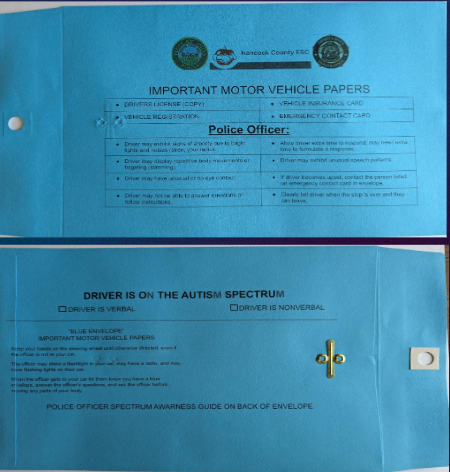The Blue Envelope Program
Implemented collaboratively by the Hancock County Education Service Center, Findlay Police Department, and Hancock County Sheriff's Office.
May 2025

The Blue Envelope initiative represents a collaborative effort aimed at fostering a safer and more understanding environment for drivers with autism spectrum disorder during traffic stops. It involves a specially designed envelope that holds a driver's essential documents—license, registration, emergency contact card and proof of insurance. The envelope features communication guidelines on its exterior, specifically tailored to assist law enforcement officers in their approach when interacting with a driver who has autism.
OBJECTIVES:
• Enhancing Understanding: By providing officers with immediate, accessible information about autism, the Blue Envelope aims to promote empathy and patience, leading to more positive interactions.
• Reducing Anxiety: Traffic stops can be particularly stressful for individuals with autism. The Blue Envelope serves as a visual cue that helps officers adjust their communication style, thereby reducing anxiety for the driver.
• Streamlining Communication: The guidelines on the envelope offer practical tips for officers, making it easier for them to communicate effectively with individuals with autism.
• Encouraging Preparedness: For individuals with autism and their families, the Blue Envelope is a tool that encourages preparedness. By keeping their important documents in the envelope and understanding how to present it during a stop, drivers can feel more confident and secure.
Preparing Your Envelope
Once you have your Blue Envelope, the next step is to prepare it properly to ensure it serves its intended purpose during a traffic stop.
1. Gather Your Documents: Collect your copy of your current driver's license, vehicle registration, and proof of insurance
2. Place Documents Inside: Insert these documents into the Blue Envelope. The envelope's design ensures that your documents are secure yet easily retrievable.
3. Consider Attaching to Your Sun Visor or Ensuring Accessibility: For ease of access, consider attaching the Blue Envelope to the sun visor on the driver’s side of your vehicle or any other easily accessible and visible location. This placement ensures that the envelope is readily available should you need to present your documents quickly. The envelope is designed to be easily noticed by law enforcement, signaling them to adjust their communication approach.
4. Inform Family Members: If you share your vehicle with family or friends, inform them about the Blue Envelope and its purpose. This is crucial for ensuring that anyone driving your vehicle knows where the documents are and understands the importance of the envelope.
5. Regularly Update Your Documents: Make sure to replace any documents in the Blue Envelope with their current versions. Keeping your information up-to-date is essential for avoiding any complications during a traffic stop.
Remember, the Blue Envelope is more than just a holder for your documents; it's a communication tool designed to bridge the gap between drivers on the autism spectrum and law enforcement.
Tips for a Safe Traffic Stop For Drivers on the Autism Spectrum:
1. Stay Calm: Try to remain as calm as possible. Deep breathing can help manage stress levels.
2. Use Your Blue Envelope: When the officer approaches your car, say "I have a Blue Envelope". Keep your Blue Envelope in an easily accessible, visible place like the sun visor. If the officer is unaware of the purpose of the Blue Envelope, politely request that they read it.
3. Follow Instructions: Listen to the officer’s instructions and try to follow them as best as possible. If you don’t understand something, asking for clarification is okay.
4. Waiting: When the officer needs to return to their cruiser, you will need to wait in your car for them until they come back. When the officer comes back, they will explain the end of the stop and tell you when to leave. Please note, a traffic stop may end with a traffic citation or a traffic warning.
5. Safety First: Always keep your hands visible and avoid making sudden movements
6. Hand Placement: Keep your hands on the steering wheel until otherwise directed, even if the officer is not at your car.
7. Flashing Lights and Noise: Remember that the officer may shine a flashlight in your car, may have a radio, and may have flashing lights on their car.
8. Calling Contact: In a situation where you feel overwhelmed or unable to communicate clearly, you can request the officer to contact your designated emergency contact on your envelope.
For Law Enforcement Officers:
display repetitive body movements or fidgeting and have unusual eye contact.
1. Recognize the Blue Envelope: The Blue Envelope signals that the driver is on the autism spectrum. Note the communication tips provided on the envelope.
2. Exercise Patience
3. Clear Communication: Use simple, direct language and give one instruction at a time.
4. Be Observant: Pay attention to non-verbal cues indicating the driver is feeling overwhelmed or stressed. Individuals on the autism spectrum may
Frequently Asked Questions (FAQ)
Q: Who can request a Blue Envelope?
A: Any individual diagnosed with autism spectrum disorder who drives residing in the Hancock county area can request a Blue Envelope. If the individual is a minor, a parent or guardian may request it on their behalf. Envelopes may be picked up at the Hancock ESC (Angie Toland), Hancock County Sheriff’s Department or Findlay Police Department.
Q: How much does a Blue Envelope cost?
A: The Blue Envelope is provided free of charge.
Q: What documents should be kept in the Blue Envelope?
A: A copy of your driver's license, vehicle registration, insurance card, and emergency contact card. (We don’t recommend keeping your original driver’s license in the envelope.) These documents are typically requested during a traffic stop.
Q: How do law enforcement officers know about the Blue Envelope program?
A: Not all officers are familiar with this program. This is a new program and officers in other areas may not be aware of it. If they are not, ask them to please read the envelope. The envelope is designed to assist in communication between the officer and the driver. The envelope does not ensure that the driver will not possibly receive a traffic citation. The traffic stop will conclude with either a warning or a traffic citation.
For further inquiries, please contact Angie Toland, tolanda@hancockesc.org
-Originally posted by: Franklin, Ohio Division of Police, 400 Anderson Street, Franklin, OH 45005, 937-746-2882, FranklinOhio.org
